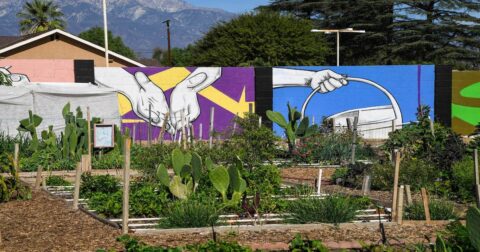Explainer
7 Tips for a More Sustainable Holiday Celebration
Climate•4 min read
Feature
Water disputes can harm community food systems. But resolving these fights is no simple feat.


Words by Jenny Splitter
Marieke Furnee moved to the U.S. more than two decades ago. She emigrated from Haarlem, a city in the Netherlands, searching for a more rural life growing fruit and vegetables in the Sierra foothills of California. Ten years ago she finally began planting a small community garden on her quarter of an acre property.
Many of Furnee’s neighbors moved to the region with similar dreams — there are wineries, fruit and vegetable farmers and a few farmers raising sheep — both in the small town of Oregon House where Furnee lives as well as in Dobbins, the neighboring foothills town. She and her neighbors were hoping to build something — what Furnee calls “a community-based food system.” But now that local food system is threatened because of a vicious and personal battle over water playing out in the foothills, with little hope of a ceasefire.
Over the past few years, water disputes have become more common in California. Conflicts like the one in North Yuba can end up hurting small, community-based farming, according to an October 2021 report from the environmental advocacy group Food and Water Watch. But because there is no single underlying cause of these disputes — not drought, land disagreements, complex water rights, or a lack of transparency — resolving them is no simple feat. No single person or agency can solve this ongoing problem — at least not on their own.
Oregon House was the perfect place to start a small farm, Furnee thought. “It’s untouched soil,” with plenty of sunlight and — most critically — water. The foothills residents have well water, but also a supply of irrigation water for farming thanks to canals that are hundreds of years old.
Everything changed in 2013. The farmers began experiencing interruptions to their water service and, in some years, received no irrigation water at all.
As a result, farming projects in the region have been damaged, delayed or destroyed, including community farms growing fruits and vegetables for a food bank and for patients at the local hospital. “One very successful vegetable farmer in Oregon House had to stop entirely,” says Furnee.
The residents blame the small water district’s management — three resident lawsuits are currently pending against the utility — but the agency has blamed leakage from canals and competing residential water needs. North Yuba Water did not respond to requests for comment.
Willie Whittlesey, the general manager for the larger county-wide water agency in Yuba, has been trying to bring the parties together for months for negotiations. The irrigation customers do have a valid question, Whittlesey says — “do you have a plan to fix whatever condition is preventing you from getting us water?” Despite his own countless attempts to get to the bottom of the facts, Whittlesey still doesn’t feel like he has the answers. “I don’t know what the major impediment is.”
California is experiencing a severe drought — 48 percent of the state now suffering from extreme weather conditions — but the drought is not the underlying cause of water inequities in the state, according to Food and Water Watch researchers. The foothills didn’t even have a particularly dry year in 2022 so far, says Whittlesey, due mostly to some unseasonable rains that skipped other regions in the state.
Drought has made existing problems worse, however, according to the group’s 2021 report. The entire system (or set of systems) is very complicated, and in many cases not transparent. “There are often layers and layers of wholesalers and water districts that touch the water before it ever gets to a residential home,” says Caroline Wren, a researcher with the group.
Furnee has spent countless hours digging through different state and local water regulations in order to advocate for herself and her neighbors. That’s not surprising to Wren. “Some of those allocations are based on water rights that are complicated, old, hard to find,” she says. And many small-scale farmers lose out because they lack “senior water rights.”
Even as rural residents like Furnee are struggling, some of the most powerful agricultural industries in the state have continued their water-intensive operations.
According to Food and Water Watch’s report: “Agriculture accounts for 80 percent of the water used in California. In 2018, farms across the state used an estimated 7.9 trillion gallons.” Not every water-intensive agriculture operation in California is connected to animal farming, but most are, including alfalfa farms supplying feed to livestock and industrial dairy operations.
“Food & Water Watch estimates that it takes 142 million gallons of water a day to maintain the dairy cows on California’s mega-dairies — more than enough water to provide the daily recommended water usage for every resident of San Jose and San Diego combined,” according to the report.
In addition, one of the most powerful food companies in California, the Wonder Company, has also managed to negotiate water rights for its almond growers in recent years despite drought conditions.
Large agribusinesses have financial resources to pursue water access strategies out of reach for many small farms. “Large agricultural companies can often afford to drill deeper groundwater wells,” says Wren, sometimes thousands of feet deeper to get water access. That type of drilling typically costs hundreds of thousands of dollars. “But if you’re a large agribusiness, you can afford to continue drilling or to drill a new well,” she says.
The downside of all that drilling is that the state is losing its water supply. Between 2011 and 2015, California “lost eight trillion gallons from its overall water reserves, two-thirds of that from its underground aquifers,” according to reporting in The New York Times.
In 2014, the state passed the Sustainable Groundwater Management Act to curb the drilling, but the law will take effect slowly over the next 20 years. And some environmental groups argue the law favors large agricultural operations, depriving small farmers of access to shallow water wells while giving them no other options.
In the foothills, some residents are able to drill to reach shallow groundwater but finding reliable water isn’t guaranteed. “Some people find water 50 feet below the soil. They’re the lucky ones,” says Furnee.
“California’s water allocation system is broken because it’s so heavily weighted in favor of corporate agriculture, but it doesn’t have to be,” says Wren. “Governor Newsom and the state legislature can declare water a public trust resource and not a commodity to be sold to the highest bidder.”
Lawmakers in California should intervene, adds Wren. “Water could be rerouted to more beneficial uses,” she says. Food and Water Watch is an advocate for small-scale farms, so Wren would rather see support for small regenerative operations, she says, and the ones with “less thirsty crops and less extractive systems of production.”
Whittlesey says a healthy, well-functioning water utility needs to be transparent, providing residents with “clear reporting on the actual water conditions that exist.”
Most importantly, there has to be a path for resolving disputes.
“When customers have a grievance or an issue, like Marieke and her friends have, there should be a guiding document for the aggrieved party and the water entity,” says Whittlesey. “[Something that says] here are the challenges and here’s how I’m going to get past the challenges, and it may take this much time and this much funding, but these are the steps we’re taking… that may not exist thoroughly enough in North Yuba,” says Whittlesey. “I know it’s a simple premise, but I think that is fundamental.”